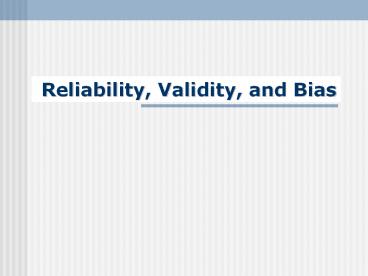Reliability, Validity, and Bias - PowerPoint PPT Presentation
1 / 7
Title:
Reliability, Validity, and Bias
Description:
Reliability. Reliability. is the extent to which an experiment, test, or any measuring procedure yields the same result on repeated trials. Without the agreement of ... – PowerPoint PPT presentation
Number of Views:151
Avg rating:3.0/5.0
Title: Reliability, Validity, and Bias
1
Reliability, Validity, and Bias
2
Reliability
- Reliability is the extent to which an experiment,
test, or any measuring procedure yields the same
result on repeated trials. - Without the agreement of independent observers
able to replicate research procedures, or the
ability to use research tools and procedures that
yield consistent measurements, researchers would
be unable to satisfactorily draw conclusions,
formulate theories, or make claims about the
generalizability of their research.
3
Validity
- Validity refers to the degree to which a study
accurately reflects or assesses the specific
concept that the researcher is attempting to
measure. - While reliability is concerned with the accuracy
of the actual measuring instrument or procedure,
validity is concerned with the study's success at
measuring what the research set out to measure. - Researchers should be concerned with both
external and internal validity.
4
External Validity
- External validity refers to the extent to which
the results of a study are generalizable or
transferable.
5
Internal Validity
- Internal validity refers to
- (1) the rigor with which the study was conducted
the study's design, the care taken to conduct
measurements, and decisions concerning what was
and wasn't measured - (2) the extent to which the designers of a study
have taken into account alternative explanations
for any causal relationships they explore - In studies that do not explore causal
relationships, only the first of these
definitions should be considered when assessing
internal validity.
6
Bias
- Systematic errors in the way the sample
represents the population. - The police decide to estimate the average speed
of drivers using the fast lane of the motorway
and consider how it can be done. One method
suggested is to tail cars using police patrol
cars and record their speeds as being the same as
that of the police car. This is likely to produce
a biased result as any driver exceeding the speed
limit will slow down on seeing a police car
behind them.
7
Bias can be due to
- Undercoverage
- Nonresponse
- Behavior of the interviewer or respondent
- Poorly worded questions































